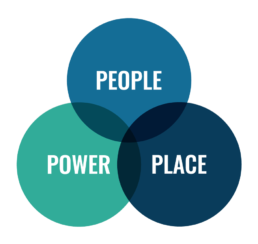What do biological ecosystems and workplace training have in common?
The ecosystem approach, successfully applied by various disciplines (e.g. innovation studies, urban planning, sociology), is finally getting popular in the field of organisational development, where it brings the idea that learning in organizations takes place in a complex network consisting of people and things that interact dynamically at different levels and create value for all the actors of the ecosystem.
According to this philosophical position, training is no longer an isolated event, but a flow of discoveries, interactions, opportunities, and multilateral exchanges. The ecosystem approach also changes the way we understand the mission of training itself: to develop an innovative culture and a specific mindset targeted at flexibility and continuous learning, that should enable people and the entire organization to “learn to learn by learning”.
Don’t we already have enough models and paradigms?
New technological infrastructures in organizations boosted internal disintermediation, compressed times of organizational decision-making processes, removed hierarchical levels and increased flexibility. As a result, the need for collective intelligence arose, to promote connectivity, mobilization, aggregation and productive discussions.
It’s becoming increasingly clear that to seize opportunities offered by the digital revolution, businesses should shift towards next-gen organizational models supported by new cultures. These emerging organizational models highlight and value pluralism, diversity of opinions and mutual adjustment between internal and external actors of the organization. The ecosystem approach in a particular way fits this condition as it invites for the first time to overcome the fragmented vision of training and to embrace the emerging complexity by putting infrastructures, tools, spaces, and people with their skills into a dynamic relationship. Indeed, the training ecosystem is understood as alive and constantly evolving.
What are the essential elements of the training ecosystem?

In the recent book of Raoul C.D. Nacamulli and Alessandra Lazazzara “The training ecosystem”(in italian “L’ecosistema della formazione”), to which I had a pleasure to contribute to, the structure of training ecosystems is addressed. The three components identified by authors are the “P mix”: People, Power and Place. For building a learning society capable of sensing and facing the challenges of the digital age, it is important that each component of the ecosystem is stimulated, accelerated or even moderated by the other two.
The three P of the training ecosystem design

People
This component describes the plurality of actors involved in the learning process. It implies the cross-fertilization between identities, stories, skills of different categories of participants, who should recognize their complementarity to be able to learn from each other
Power
This component describes the resources and energies of all people working in the ecosystem, that training is called to activate and mobilize. There are many methodologies, old and emerging, that aim to give more creative/productive force to people (e.g. design thinking design thinking, coaching, mindfulness…).
Place
This component describes the multiplicity of spaces where open and continuous training occurs. It highlights the aptitude to live in an integrated and synergic way the physical/virtual environments and brings us closer to a “phygital” future.
What does it mean to embrace an ecosystem approach in your work?
This paradigmatic change forces us to think about training in terms of complexity, scalability, openness, non-linearity, and non-predictability. Consequently:
- we should restructure our relationship with learners in a “consultant-client” perspective, which is inspired by the idea of empowerment and learner-centricity.
- We cannot expect to have a set of instructions for solving today’s problems: instead, we should empower critical and adaptive thinking, that will support the resilience and responsiveness of entire systems.
- We must prepare ourselves to be in contact with a variety of different organizational worlds, to promote inclusiveness and to create common languages and goals.
- It is useful to stay in an “in-between” space, inside and outside the organization, to capture important signals for mobilization.
- We need to overcome obsolete contrasts e.g. human/machine, company/employee, teacher/student, and to elaborate new, integrated and complementary ways of thinking.
- We must exploit the possibilities offered by hybridization of physical/virtual spaces and the constant Internet connection (“always-on”) to advance new scenarios of active and participatory learning processes.
When ecosystems face external impulses, they may react either by modifying part of their organization and transforming the biotic components or by undergoing structural changes that lead to new ecosystems taking place of the modified ones.
These patterns of ecosystem alterations help us to understand that training alone may not be enough, or it may be even useless (e.g. when the infrastructural or organizational transformation is needed). The future of training, therefore, is inevitably embedded in organizational development and technological transformation.

written by:
Iryna Prus, isapiens Client Success Manager
SHARE!

